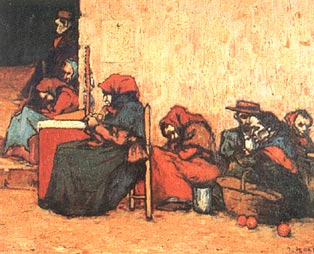It’s that time of the year
You can walk into the Met on a Sunday and walk around without jostling crowds and waiting in queues. There’s much to be seen. And some of it like Barcelona and Modernity: Gaudí to Dalí you should see soon because there’s a lot to take in and you might want to come back before June 3rd when the exhibition is slated to end.
The exhibition welcomes you with a small Picasso that marries Goya with Manet. The Catalan revival showcased in the exhibition owes a lot to Francophile painters and sculptors who made trips to France and were heavily influenced in both style and content by French art of the period. You can see Montmartre’s favorite haunts painted by Toulouse-Lautrec and Degas rendered here by the founders of Catalan Modernisme . In their palette and in their themes they bear so much resemblance to French painting that the first half of the exhibition could practically be shown seamlessly with French impressionism and works by Rodin and Maillol.
The Met will tell you that: At the turn of the 20th century, while the rapid industrialization of Barcelona created new fortunes and allowed for wide patronage of the city's artists and designers, poor immigrants worked in harsh and unjust conditions, leading to social conflict, labor strikes, and anarchist bombings. Although artists rarely made overtly political statements, they did look closely at both the wealthy bourgeoisie and the working poor. Paintings and drawings by Isidre Nonell and Picasso's Blue Period depictions of beggars, prostitutes, and the disenfranchised reflect on the striking differences between Barcelona's economic and social classes. But I have a bone to pick with them on Nonell whose painting Poor People Waiting for Soup
is on view.
 The Met cites his influences as Goya and Honoré Daumier where as to me the influence of Jean-Fraçois Millet is so evident and blatant that to skip the reference seems like a mistake. Any Nonell experts out there who can shed some light?
The Met cites his influences as Goya and Honoré Daumier where as to me the influence of Jean-Fraçois Millet is so evident and blatant that to skip the reference seems like a mistake. Any Nonell experts out there who can shed some light?Some of Picasso’s more accomplished and sublime pieces are on view at the Met and any Picasso fan should be delighted. His Harem from 1906

is of course influenced by Ingre but I disagree once again with the Met that it’s Ingre’s Turkish bath or harem paintings that is the primary influence. It is rather the mood of Ingre's Angélique that permeates Picasso’s Harem. Picasso's Gosol Landscape has Cezanne written all over it (another reference I believe the curators decided to skip).

It is Dali fans who will be disappointed by this exhibition because there are fewer works by Dali than by Picasso or Miró or Rusiñol. There is, alas, not enough of Joaquim Mir whose landscapes share some of the strangeness of Max Ernst’s post-war work. And you’ll see one of Miró’s earlier pieces which tells you why he was so right to turn to contemporary expression in his own work!
My coup de cœur was one of Picasso’s magnificent blue period works La Vie. Decipher it!
 © metmuseum.org
© metmuseum.org

1 Comments:
Hello!
Je vous ai "découverte" grâce à Tatiana (de Rosnay). Et lorsque j'ai vu que vous seriez à Montpellier (ma ville) pour la Comédie du Livre, je me suis empressée de commander votre Babyji!
J'espère vous voir sur la Comédie le mois prochain! :)
Post a Comment
<< Home